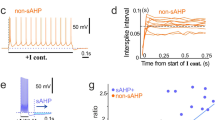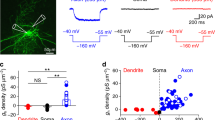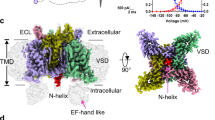Abstract
It is becoming increasingly clear that nerve cells in the mammalian central nervous system (CNS) have a very complex electroresponsiveness. They exhibit not only time- and voltage-dependent Na+ and K+ conductances, analogous to those in the squid giant axon1, but also a variety of other conductances that have a significant role in the control of cell excitability. Of the outward currents, there are, in addition to the delayed rectifier, the Ca2+-activated K+ current2,3 which underlies the long-lasting spike afterhyperpolarization, and the M current4, a non-inactivating K+ current evoked by membrane depolarization and blocked by muscarinic, cholinergic agonists. We demonstrate here the existence in a mammalian central neurone (hip-pocampal CA3 pyramidal cells) of yet another outward current, which is transient and may be carried by K+ ions. Further, the experiments show that this current is substantially reduced by the convulsant 4-aminopyridine (4-AP)5, resulting in a marked increase in cell excitability.
This is a preview of subscription content, access via your institution
Access options
Subscribe to this journal
Receive 51 print issues and online access
$199.00 per year
only $3.90 per issue
Buy this article
- Purchase on Springer Link
- Instant access to full article PDF
Prices may be subject to local taxes which are calculated during checkout
Similar content being viewed by others
References
Hodgkin, A. L. & Huxley, A. F. J. Physiol., Lond. 117, 500–544 (1952).
Hotson, J. R. & Prince, D. A. J. Neurophysiol. 43, 409–419 (1980).
Krnjevic, K., Puil, E. & Werman, R. J. Physiol., Lond. 275, 199–223 (1978).
Adams, P. R., Brown, D. A. & Halliwell, J. F. J. Physiol., Lond. 317, 29P (1981).
Galvan, M., Grafe, P. & Bruggencate, G. ten. Brain Res. 241, 75–86 (1982).
Djorup, A., Jahnsen, H. & Laursen, M. Brain Res. 219, 196–201 (1981).
Galvan, M. & Adams, R. Brain Res. (in the press).
Brown, D. A. & Adams, P. R. Nature 283, 673 (1980).
Constanti, A. & Brown, D. A. Neurosci. Lett. 24, 289–295 (1981).
Adams, D. J., Smith, D. J. & Thompson, S. H. A. Rev. Neurosci. 3, 141–167 (1980).
Connor, J. A. & Stevens, C. F. J. Physiol., Lond. 213, 21–30 (1971).
Adams, P. R., Brown, D. A. & Constanti, A. in Physiology and Pharmacology of Epilep-togenic Phenomena (eds Klee, M. R., Lux, H. D. & Speckmann, E.-J.) 175–187 (Raven, New York, 1982).
Thompson, S. H. J. Physiol., Lond. 265, 465–488 (1977).
Kenyon, J. L. & Gibbons, W. R. J. gen. Physiol. 73, 139–157 (1979).
Hille, B. J. gen. Physiol. 50, 1287–1302 (1967).
Constanti, A., Adams, P. R. & Brown, D. A. Soc. Neurosci. Abstr. 7, 14 (1981).
Connor, J. A. & Stevens, C. F. J. Physiol., Lond. 213, 31–53 (1971).
Shimahara, T. Neurosci. Lett. 24, 139–142 (1981).
Thesleff, S. Neuroscience 5, 1413–1419 (1980).
Author information
Authors and Affiliations
Rights and permissions
About this article
Cite this article
Gustafsson, B., Galvan, M., Grafe, P. et al. A transient outward current in a mammalian central neurone blocked by 4-aminopyridine. Nature 299, 252–254 (1982). https://doi.org/10.1038/299252a0
Received:
Accepted:
Issue Date:
DOI: https://doi.org/10.1038/299252a0
This article is cited by
-
Cholinergic dependence of a cortical neuronal mechanism that supports pavlovian eyeblink conditioning
Neuroscience and Behavioral Physiology (1997)
-
Chaos and synchrony in a model of a hypercolumn in visual cortex
Journal of Computational Neuroscience (1996)
-
Slow low-threshold potassium current inHelix pomatia neurons
Neurophysiology (1995)
-
4-Aminopyridine-induced synaptic GABAB currents in granule cells of the guinea-pig hippocampus
Pfl�gers Archiv European Journal of Physiology (1993)
-
Tetrandrine blocks a slow, large-conductance, Ca2+-activated potassium channel besides inhibiting a non-inactivating Ca2+ current in isolated nerve terminals of the rat neurohypophysis
Pfl�gers Archiv European Journal of Physiology (1992)
Comments
By submitting a comment you agree to abide by our Terms and Community Guidelines. If you find something abusive or that does not comply with our terms or guidelines please flag it as inappropriate.



